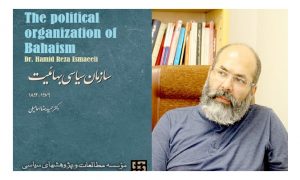There are various references for recognizing and investigating Bahaism most of which have analyzed Bahaism as a cult having a theological root, but the important aspect of the cult is its organizational nature. Although it has been repeatedly mentioned, but all of its phases haven’t been specially analyzed. In a work which has been recently published by the political studies and researches institute written by Dr. Hamid Reza Esmaeeli and late researcher called Ali Akbar Ranjbar Kermani, Bahaism has been presented as an organization which has organizational complexities. Nearly 20 pages of the book are assigned for the introduction which explain the organizational concepts. The concepts like: A general glance at organization, the difference between foundation and organization, the organizational theory and concepts, determining borders for the organization and environment of closed and open system, formal and informal organization, dividing and rationalizing the job process, the kinds and classifications of organizations and etc.
Generally speaking, these elements are important for the organization:
- A collection of human beings and the relationships between them
- The important aim around which the humane forces have gathered
- Planning and administrative discipline.[1]
One of the notes in the last part of the introduction of the book concerning organization is hiding method in some political organizations. Hiding means to conceal the aim which can be said less in the form of an aim is acceptable for the community.[2]
After the introduction, six chapters of the book start including Bahaism movements since the emergence to the Islamic Revolution.
The first Chapter called “from Babism to Bahaism Colony explaining about the first cores of Babism movement, Sheikh Ahmad Ehsaee and seyyed Kazem Rashti’s pupils.
One of the important parts of the 1st chapter is analyzing the hypothesis of the foreign origin of the emergence of s Babism. Five hypotheses have been stated about the origin of Babism an along with documents:
– Intriguing Seyyed Ali Muhammad Shirazi and supporting him by Russia.
– Intriguing Ali Muhammad Shiraz and supporting him by England.
– Boycotting Mullah Hussein Boshrouyee and supporting him by the British agents.
– Penetrating via Seyyed Kazem Rashti and its continuation in Babism.
– Competing Russia and England over managing Babis after Babis measure and riots.
Then the historical events such as aborted coup 1267 A.H. and aborted assassination of Naser-al-Din Shah in 1268 A. H.
According to the author, Bahaism hasn’t been a political organization during Hussein Ali Nouri, the first head of Bahaism. It has been merely a cult which was successful to attract Baha’ism leftovers.
The second chapter is entitled “The new Bahaism and the establishment of Bahaism organization”. It explains about how Bahaism could attract the attention of newly emerged political powers like America using the new policies of Abbas Effendi and changing the old interaction with Russia and England and create a new phase for the cult. [3]
One of the important events in this period of time for Bahaism were Abbas Effendi’s trip to America and proselytizing and consults during this trip. His trip contained the following aims:
- Consulting with statesmen and American and European authorities,
- Consulting with political and theological foundations of the west particularly the Christians, Jewish and Theosophists,
- Proselytizing and helping the Bahaism organization be organized in Europe and he America which was recently formed.[4]
After the trip, the first cores of Bahaism organization were formed in the United States establishing Bahaism organizational assemblies in Chicago and several American cities.
The third chapter of the book is entitled the transformations of Bahaism being organized in Iran, before the establishment of the universal house of justice. Shoqi Effendi, the third leader of Bahaism elected some Iranian and America Baha’is as the heads of Baha’i faith during his leadership. They gathered together in 1336 in Haifa (the center of Baha’i management) after his death. The author has explained about the process of the formation of the main center of Baha’i management called the universal house of justice and in chapter 4, he describes the political organization of Bahaism after the establishment of the universal house of justice.
The two last chapters of the book called” Bahaism, Judaism, Zionism and Israel” and “Bahaism and Pahlavi government” explain about the bond between Bahaism and Zionism and its role in Pahlavi government in details. It seems the author has been successful in achieving the following aims:
- presenting a narration of history of Bahaism reflecting its political nature in the history of two centuries ago.
- Pinpointing the course of historical transformation of organizing Bahaism along with documents and reasons.
- Investigating and analyzing aim, ideology, plans and activities of the political organization of Bahaism at the present time.
[۱] Esmaeeli, Hamid Reza, the political organization of Baha’ism (1892-1979), Tehran, political studies and researches institute, 1400, P.16.
[۲] Ibid, p.32.
[۳] Ibid, pp.132-133.
[۴] Ibid, pp. 153-154.






